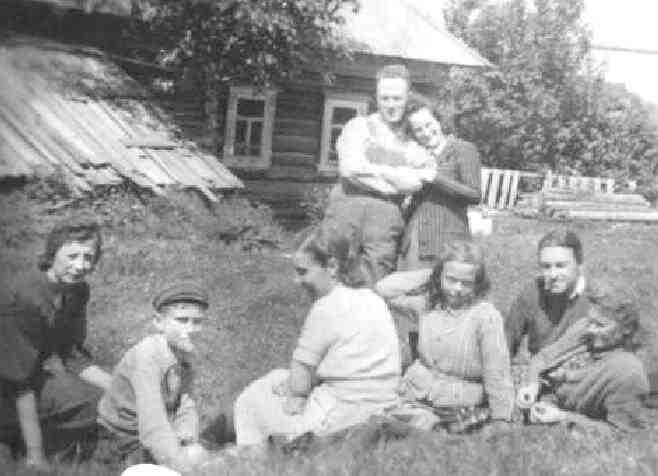
World War II: Soviet Deportations of Estonians--Conditions

Figure 1.--Here are deported Estonians and Jews (I'm not sure where the Jews were from) in Kirov Oblast, Sovetski Region, during Summer 1941. From left to right are the Jaansoo family (Maria and son Albert) together with the members of the large Vassermann and Goldmann family photographed in front of their dwellings.
|
The initial years od deportment were times of great hunger and misery. I am a little unclear as to the situation and conditions. Those who were arrested lived in prison camps. Conditions there were dreadful and most died within a few much of arrival, especially during the Winter. I think but am unsure that the families lived in nearby settlements. The families at first seem to have lived in baracks and latter small cottages. The arrested individuals were involved in hard mannual labor, essentially as slaves. The adult family members despite their skills are education were also employed in mannual labor. Presumably they were paid, but I have few details. I do not know to what extent schools were set up for the children or at what age the young people were expected to begin working. We know that schools were operating by 1946. Deportees, however, had dificuly gaining acceptance to universities. Nor do I know to what extent the arrested individuals in the camps were allowed contact with their family in the nearby settlements.
Living Situation
The initial years were times of great hunger and misery. I am a little unclear as to the situation and conditions. Those who were arrested lived in prison camps. Conditions there were dreadful and most died within a few much of arrival, especially during the Winter. I think but am unsure that the families lived in nearby settlements. The families at first seem to have lived in barracks and latter small cottages. Several families would have been assigned to barracks. They were apparently allowed to hang up sheets are partition off the barracks into family areas. Many families would have been affected by the loss of the head of household in the camps as in most cases he had been the principal bread winner.
Labor
The arrested individuals were involved in hard mannual labor, essentially as slaves. The adult family members despite their skills are education were also employed in mannual labor. Presumably they were paid, but I have few details.
I do not know to what exctent schools were set up for the chikdren or at what age the young people were expected to begin working. We know that primarily schools were operating by 1946. One wonders what the children were told about the deportment in the schools. Presumablt the teachers were Russians. Secondary schools were also eventually established. Deportees, however, had dificuly gaining acceptance to universities.
Camps
Nor do I know to what extent the arrested individuals in the camps were allowed contact with their family in the nearby settlements.
Sources
Kistler-Ritso Estonian Foundation. (We used an article in their web site, but I am nor sure who the author was or what the title of the article was.)
HBC

Navigate the Boys' Historical Clothing Web Site:
[Return to Main Soviet occupation of Estonia page]
[Introduction]
[Activities]
[Biographies]
[Chronology]
[Clothing styles]
[Countries]
[Bibliographies]
[Contributions]
[FAQs]
[Glossaries]
[Satellite sites]
[Tools]
[Boys' Clothing Home]
Created: April 12, 2004
Last updated: April 12, 2004



